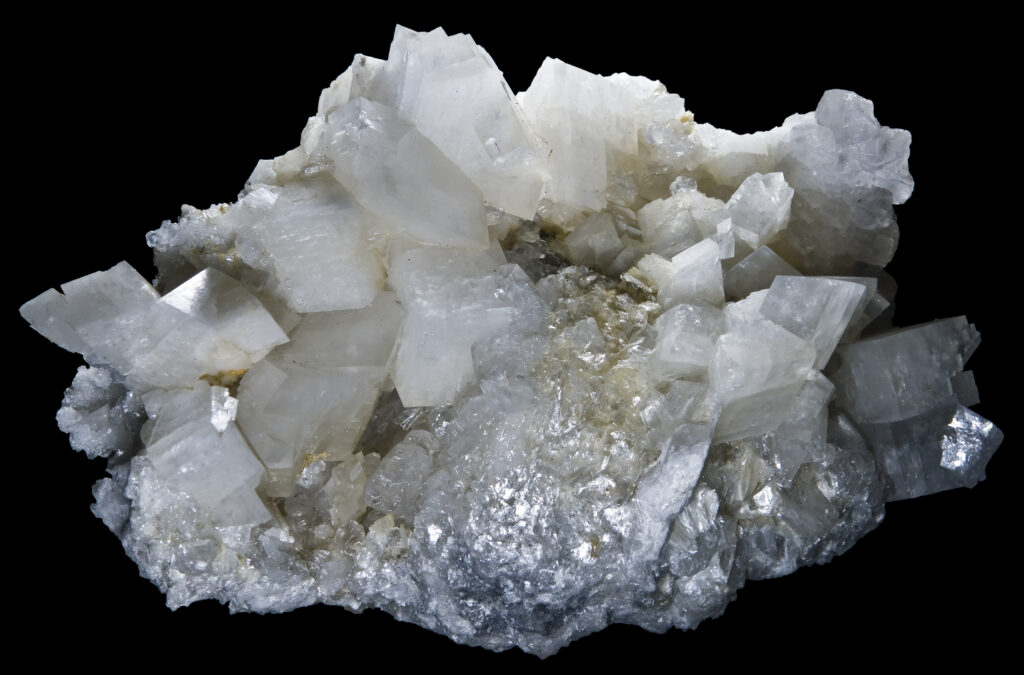
Dolomite: Gemstones Information
Dolomite is CaMg(CO3)2 and forms transparent colorless to light yellow rhombohedral crystals of the trigonal system. The hardness is 3.5–4 and there is one direction of perfect cleavage. Faces may sometimes be curved. The SG is 2.8–2.9, and the RI 1.502 and 1.681 with birefringence of 0.179, uniaxial negative. Dolomite occurs in a number of conditions: in sedimentary rocks, in altered Mg-rich igneous rocks or in geodes.
Perhaps the finest transparent dolomite crystals are those found at Eugui, Navarra Province, Spain. Massive dolomite or ‘dolomitic marble’ is often banded and in colors of red, brown, yellow, green and white. Such material comes from the US and Brazil.
Dolomite: Unveiling the Natural Beauty and Versatility of the Magnesium Mineral
Dolomite, a versatile mineral renowned for its natural beauty and diverse applications, stands as a geological treasure appreciated by scientists, collectors, and industry professionals alike. Named after the French mineralogist Déodat Gratet de Dolomieu, dolomite has captured the fascination of enthusiasts worldwide. Delving into the realm of dolomite unveils a story of geological significance, aesthetic appeal, and practical utility.
Formation and Characteristics:
Dolomite is a calcium magnesium carbonate mineral that forms through the replacement of calcium by magnesium in limestone or marble. It belongs to the trigonal crystal system and is typically found in sedimentary rock formations. Dolomite is characterized by its white to gray coloration, often with pink or green hues due to impurities, and its vitreous to pearly luster. The mineral often occurs in massive form, as well as in well-formed crystals.
Physical and Chemical Properties:
Dolomite possesses several physical and chemical properties that contribute to its versatility and utility. It has a Mohs hardness of 3.5 to 4, making it relatively soft compared to other minerals. Dolomite is insoluble in water and has a relatively low acid reaction, distinguishing it from other carbonate minerals. Chemically, dolomite is composed of calcium carbonate and magnesium carbonate, with a chemical formula of CaMg(CO3)2.
Geological Significance:
Dolomite plays a significant role in the formation of sedimentary rocks, particularly in carbonate-rich environments. It often occurs as a secondary mineral in limestone and marble, resulting from the alteration of calcium carbonate minerals by magnesium-rich fluids. Dolomite beds and formations are important geological features, providing valuable insights into past environmental conditions and geological processes.
Industrial Applications:
Dolomite is valued for its diverse industrial applications across various sectors. In the construction industry, dolomite is used as a building material for aggregate, concrete, asphalt, and cement production. Its high calcium and magnesium content make dolomite an ideal soil conditioner for agricultural purposes, helping to neutralize acidity and improve nutrient uptake. Dolomite is also used in the manufacturing of refractory bricks, ceramics, glass, and steel production.
Decorative and Ornamental Uses:
Dolomite’s natural beauty and aesthetic appeal make it a popular choice for decorative and ornamental purposes. It is used as a dimension stone for carving sculptures, architectural elements, and ornamental objects. Dolomite’s subtle color variations, including white, gray, pink, and green, add visual interest and character to interior and exterior design projects. Polished dolomite slabs and tiles are prized for their smooth texture and elegant appearance in countertops, flooring, and wall cladding.
Metaphysical Properties:
In the realm of metaphysics and alternative healing practices, dolomite is believed to possess grounding and balancing properties. It is associated with promoting emotional stability, mental clarity, and spiritual growth. Dolomite is often used in crystal healing to align the chakras, balance energy flow, and enhance meditation practices. The mineral’s calming energies are thought to promote relaxation, tranquility, and a sense of inner peace.
Environmental Considerations:
While dolomite offers numerous benefits and applications, its extraction and processing can have environmental implications. Mining activities associated with dolomite extraction may result in habitat disruption, landscape alteration, and water pollution if not managed properly. Additionally, the transportation and processing of dolomite may contribute to carbon emissions and energy consumption. Sustainable mining practices and environmental regulations are essential for mitigating these impacts and ensuring the responsible use of dolomite resources.
Conclusion:
Dolomite stands as a testament to the natural beauty and versatility of minerals, offering a myriad of practical applications and aesthetic possibilities. From its formation in sedimentary rocks to its diverse industrial uses and metaphysical properties, dolomite continues to captivate and inspire. Whether admired for its geological significance, cherished for its decorative appeal, or utilized for its practical utility, dolomite remains an enduring symbol of nature’s creativity and abundance.




